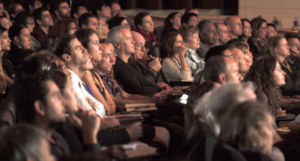Even the best presentations lose the audience. Why? Because your brain is lightning fast. You need to stay focused. What presenters can do is exactly the same to hold audience attention.

If you’re looking for inspiration, watch presentations given by the pros. One great example is TED. Organizations such as TED focus on making their conferences an emotional and memorable learning experience for their audience.
By watching some of the best speakers give unforgettable presentations, you’ll not only become inspired, but you can also try to incorporate some of their techniques in your next presentation.
In my mind, there are two kinds of attention: neck down, and neck up. Neck-up attention is when the listener has to make an effort to pay attention. Neck-down attention is when the listener is riveted to the speaker: she can’t help but pay attention.
Please note that, in our language of English, attention is paid because attention is a valuable currency. When listeners pay attention, they are rewarding you with arguably the most valuable currency in the world.
Here are some techniques that are guaranteed to earn you more attention without losing any of your professional credibility.
Using statistics
In his TED talk “Teach Every Child about Food,” chef Jamie Oliver stated, “Sadly, in the next 18 minutes when I do our chat, four Americans that are alive will be dead from the food that they eat.”
Open with a shocking and relevant statistic that communicates the urgency and importance of your presentation.

Make it about them
Now that you’ve gotten listeners’ attention with your magnetic opening, make the story about them. Increase your You-to-Me-Ratio.
Talk about their goals, their aspirations, their anxieties. Cicero, a Roman statesman and orator, and one of the greatest speakers in the history of the world said, “Tickling and soothing anxieties is the test of a speaker’s impact and technique.” He meant that you can capture attention if you remind an audience of a felt need, a pain point, or a threat to their well-being.
“Ring around the collar,” was a 1968 ad in which a housewife protected her husband from loss of social status and career disaster by using Whisk on his shirts. And many consultants I know use something called FUD to sell their projects: Fear, Uncertainty, and Doubt. A smattering of FUD gets our attention. When I feel it, I feel it in my chest.
Employing stories
In “The Danger of a Single Story,” author Chimamanda Ngozi shared how the power of stories enabled her to find her unique voice in her work.
Use engaging and personal stories to emotionally connect with and motivate the audience.
Design
In David Epstein’s talk, “Are Athletes really Getting Faster, Better, Stronger?” he uses bold slide design to show how physical feats have evolved over the years.
Use high-quality slides that are purely visual and require little to no explanation to emphasize your point.
Start with the unexpected
Start with a bang, not a whimper. Smokers like matches that light with the first strike, and listeners like presentations that ignite interest with the first sentence. For instance:
“We stand today at a place of battle, one that 40 years ago saw and felt the worst of war.”–President Ronald Reagan
“I stand before you today, the representative of a family in grief, in a country in mourning, before a world in shock.”– Earl Spencer, brother of Lady Diana.
“I wish you could have been there…”–Patricia Fripp, CSP, Former President of the National Speakers Association.
Being unexpected snaps the brain to attention. For example, I attended a presentation where a hidden presenter “typed” sentences instead of speaking. The audience was dead silent but very engaged.
In his 2014 commencement address to the University of Texas at Austin, Adm. William McRaven identified and elaborated on ten different takeaways from Navy SEAL training.
When delivering a lot of material, condense it into points that are easily remembered and organized. Preview the number of points at the beginning of your presentation to give your audience a mental roadmap of where they are in the speech.
Hold an audience attention by using props
TEDx speaker Dima Ghawi talked about breaking out of her cultural limitations and discovering the leader within. In her TEDx talk, “Breaking Glass: A Leadership Story,” Ghawi spoke of how her grandmother compared a Middle Eastern girl’s reputation to a glass vase.
If cracked or broken, it would always be seen that way. Later in life, Ghawi broke out of the imaginary glass vase of restraint.
At the end of her TEDx talk, Dima broke a glass vase onstage, and gave each member of the audience small pieces of it, wrapped with a special message, “Remember to break through your limitations.” This helped the audience stay connected with her story long after the event.
Use props or physical objects to illustrate your main points or call to action.

Arouse emotion
Humor is inherently persuasive. It gives the speaker an unfair advantage because it literally changes the chemistry in the room, and in the brain of everyone present. But don’t try to tell jokes if you’re not a comedian. Simply allow your natural sense of humor to be present at the moment, and when something comes to mind, allow your humor to reveal itself.
Confessing something personal about yourself can also make the audience feel connected with you. I had a client recently–a senior person in her company–who confessed to her colleagues at a major company meeting that she had been a bartender, a taxi driver, and short-order cook in order to pay her college tuition.
The audience was amazed and thrilled as she drove home her point that we can all do more than we realize if we have the will to do whatever it takes. One definition of courage, she said, is acting out of character.
Hold an audience attention by putting art to work
Graffiti artist Erik Wahl live-paints as he tells his story. You can use art to show firsthand the process of creating masterpieces or to tell a story through painting or drawing.
Watching a piece unfold before your eyes can be captivating for an audience.
Employing music
Benjamin Zander played live music in his TED presentation, “The Transformative Power of Classical Music.”
Playing music isn’t just a way to entertain your audience; it is also a perfect way of showing rather than telling. Besides playing music, showing rather than telling can work for demoing a technological product.
Keep it interactive
Social scientists have demonstrated that an interactive audience is more easily persuaded than a passive one. In many circumstances, the give and take between the speaker and audience breaks through the reticence and reserve of listeners, encouraging them to engage with the speaker and play a part in the proceedings.
We see this in certain churches using the call and response tradition of worship. We see it in schools and universities, where an effective teacher, by asking questions, can get monosyllabic students to open up and participate.
Employing shock and suspense
In his iPhone announcement keynote, Steve Jobs introduced the iPhone by talking about three products and merging them into one. Build up your points for a grand reveal of the big idea.
In his TED talk “Mosquitoes, Malaria, Education,” Bill Gates released mosquitos into the audience to evoke the discomfort they should feel at learning the frightening truth about malaria.
Do something out of the ordinary to illustrate your point and dare to make your audience uncomfortable if it serves the message.
Using humor
Comedian Maysoon Zayid performed a TED talk called “I Got 99 Problems … Palsy Is just One.”
Zayid told her story of living with cerebral palsy with self-deprecating humor, charm, and wit, and the audience couldn’t help but fall in love with her. She used incredibly personal material that kept the audience hooked and laughing the entire time.
Be personal and not afraid to share your flaws in front of your audience. That will make you appear more human and relatable.
Hold an audience attention using math
In “A Performance of Mathemagic,” Arthur Benjamin explains how he can compute complex mental math after competing against a calculator.
Showing off amazing or complex skills gets your audience thinking, while also serving to entertain them.
Dance
“Dance v. PowerPoint, a Modest Proposal” is a pathbreaking TED talk created through a unique collaboration between writer John Bohannon, choreographer/director Carl Flink and his dance company Black Label Movement.
As a group, they used dance to make a point about the dullness of many PowerPoint presentations.
Don’t be afraid to visualize your points through actions.
Demonstrating magic
Keith Barry puts on an incredible magic show with audience members in “Brain Magic.”
Magic is a classic form of entertainment that can be used to make a point that will really stick with an audience.
At the end of the day for any presentations, the audience wants to learn AND be entertained.
Employing science
At the World Science Festival, Bobby McFerrin showed the audience how our brains are wired to the pentatonic scale. Locations onstage corresponded to certain notes. As he moved around the stage, the audience responded with the appropriate notes on the scale. By doing so, McFerrin effectively played the audience as a musical instrument.
The result was astounding, and the audience loved it. You can watch McFerrin’s presentation on the TED website under “Bobby McFerrin Demonstrates the Power of the Pentatonic Scale.”
Engage and play with your audience. It’s important to have fun and make sure everyone feels involved.
The bottom line
Remember not to try to do too much. You don’t always have to give a TED-like performance every single time you present, but it’s important to allow yourself to be truly creative.
Express yourself and give your audience a window into your passions. Doing something unique always makes for a memorable experience.
If what you already have effectively hit the point home, that’s fine. If you aren’t accomplishing anything significant by incorporating additional elements into your presentation, then include them. Ultimately, what matters is that the audience understands your message and acts on it.
Need some help in building better customer trust from your customer engagement? Creative ideas to help grow your customer relationships?
Call today for a FREE consultation or a FREE quote. Learn about some options to scope your job and pay for results.
Call Mike at 607-725-8240.
When things are not what you want them to be, what’s most important is your next step. Call today.
Test. Learn. Improve. Repeat.
Are you devoting enough energy to improving your continuous learning for yourself and your team?
Mike Schoultz is the founder of Digital Spark Marketing, a digital marketing and customer service agency. With 40 years of business experience, he blogs on topics that relate to improving the performance of your business. Find them on G+, Twitter, and LinkedIn.
Digital Spark Marketing will stretch your thinking and your ability to adapt to change. We also provide some fun and inspiration along the way. Call us for a free quote today. You will be amazed at how reasonable we will be.
More reading on customer engagement from our library:
Communications Are Key to Building Customer Trust
Improve Customer Engagement to Win Business
Deadly Mistakes that Destroy Employee Engagement
Influence Consumer Behavior Through Personalization Strategies
Like this short blog? Follow Digital Spark Marketing on LinkedIn or add us to your circles for 3-4 short, interesting blogs, stories per week.